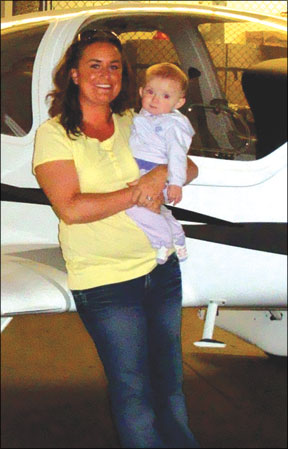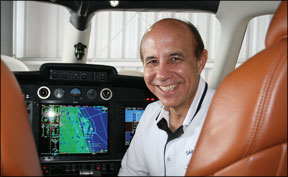You know the world has changed when your financial advisor calls gushing about what a great day the market had. It lost only 300 points on moderate trading and hes certain the bottom is near. (Until, that is, investors find a way to tap yet deeper negative stratas.)
In days of yore, stock market fluctuations far more benign than what weve seen since August have tended to spook airplane buyers into slamming their wallets shut. It stands to reason, then, that the current blood bath on Wall Street should have sent buyers burrowing deep underground, right?
Not really, according to our recent survey of aircraft brokers we know. No one

would describe the market as booming, but our interviews with brokers revealed less softness than we would have expected and, more important, there are some surprisingly good opportunities for buyers seeking deals on late-model used aircraft-prices are reasonable, inventory is high and sellers are adapting to this new reality. The world is less rosy for owners trying to sell run-of-the-mill, average airplanes, but these airplanes can still move, if the seller is willing to get the price right. (Thats another way of saying if youve got an average airframe tending toward the beater side of the spectrum, don’t expect to get a price anywhere near Bluebook value.)
Whats It Worth?
And what is Bluebook value, anyway? All of the brokers we spoke to told us that in the current market, the accepted price guides offer more heat than light on true market value.
“These books don’t mean a lot anymore,” says Jimmy Garrison of All American Aircraft, a San Antonio brokerage that specializes in Mooneys. These days, he estimates value based on his own knowledge of the market and by relying on what traditionally has been the worst way of determining value: scanning the asking prices in for-sale listings in such publications a Trade-A-Plane, Controller and Aircraft Shopper Online.
Garrison believes the market is too dynamic for survey-based pricing guides to keep up, so he scans the listings to sense price trends and, by sixth sense, knocks out the outliers that are too high. “Im a dealer who watches a specific niche, so I can look at a price in a listing and know that its just not reality,” Garrison says. Example: an owners fawned-over mid-1980s J-model Mooney with a $150,000 asking price. “Thats just not going to happen,” says Garrison.
In the current market, youd think that the sheer volume of owners trying to unload airplanes at any price would be staggering, but thats not really the case.
“Overall, the number of listings is not up,” says Trade-A-Planes Cosby Stone. “But the composition of listings has changed, probably toward having more high-end airplanes. You see a lot of later model airplanes now and thats probably where the best deals are,” Stone says.
“This is not what you would call a normal market. Its a schizophrenic market. There are people who will sell at whatever price because they have to and there are sellers who are just delusional about what their airplanes are really worth,” he adds.
Wistful Sellers
This was a sentiment we heard repeatedly in talking to brokers and dealers. None of the brokers we interviewed reported dealing with owners who are so strapped that they absolutely have to sell their airplanes right away, this despite nearly 1000-point swings in the Dow on a weekly basis.
“Were in a slower overall aircraft market, no question,” says Fred Ahles of Fort

Lauderdale-based Premier Aircraft Sales, a leading dealer/broker in Diamond, Mooney and Piper aircraft. But sales activity isn’t coupled to the stock market in the way that it once was, if it ever was.
“Younger buyers seem less worried. If theyve got money in the market, theyve got a lot longer to recover losses. Older buyers have taken the money out of the market and are into money markets, but they realize they cant stay there,” Ahles told us.
So some owners are selling to upgrade and some are selling to wait and see what develops. Either way, airplanes are moving in both directions, albeit slowly, and the best way for a seller to close the deal is to have a hot cup of reality before beginning negotiations.
“Were doing OK, but it is a tough market. There are a lot of airplanes for sale and the airplanes need to be realistically priced,” says George Johnson, whose Carolina Aircraft is a nationally known Bonanza and Baron specialist in Greensboro, North Carolina. This economic fact of life has always been true, but a soft market puts a sharper point on it.
“Most of the sellers think their airplane is the best in the world and it is, until you look under the skin,” says Johnson. “We see sellers who are totally unrealistic about price. We tell them your airplane is just not going to sell for that.” The smart ones adjust accordingly; the stubborn ones wait.
Says Fred Ahles: “Weve had buyers show us listings for the same airplane they have with prices that just arent real. We have to point out that the listing has been up for nine months. If we don’t get the price right, its going to take 45 to 60 days or longer to sell an airplane.”
And this varies sharply by model, by year and, lately, by equipment. “There’s a lot of interest in models 2000 and newer,” says Premiers Ahles, “and that means buyers are looking for glass cockpits.”
Theyre also looking for high performance airplanes that are economical. That means twins of any year arent much in demand, but late-model singles are.
Buyers Driving?
All of the brokers we spoke to agree in unison that the current market favors buyers, even if they demur on using that precise term. “How can it not be a buyers market? When you see the stock market go down as much as it has. But were only two or three weeks into it, so its early,” says Howard Van Bortel, of Van Bortel Aircraft. We spoke to him in late October.
“I hate to say that [buyers market] because thats what I hear from about every buyer who calls looking for a steal. Lets just say there are some good opportunities out there,” says Jaime Steel, whose Steel Aviation specializes in late model technologically advanced airplanes with a tilt toward Cirrus. But the problem is-and every broker we spoke to mentioned this-the world is flooded with late-model used Cirri, a consequence of Cirruss business philosophy of priming the market with frequent new models that buyers view as genuinely fresh and not just a new paint scheme.
“Cirrus has a cult-like following,” Steel observes, “and a portion of that market will buy any new airplane Cirrus makes.”
Cirrus has cleverly tapped into a vein of buyers affluent enough to write an aircraft purchase check without concern about market conditions or credit. While this has proven to be a successful business plan for Cirrus, it doesnt take many new airplane purchases to channel a lot of used airframes into the market, especially SR22s, Cirruss big ticket item.
One broker we spoke to estimated there are currently more than 200 used SR22s on the market, but we think this number is inflated. By late October, we counted 32 used SR22s in the Trade-A-Plane listings, 21 in Controller and about 55 on the Aircraft Shopper Online site. To be sure, some of these are dupes and some are trial balloons floated by owners merely testing the market, but the reality is that used Cirrus inventory is high. “The thing about Cirrus airplanes,” one broker told us, “is that theyre all almost the same, so the only thing a seller can really compete on is hours on the airframe or price.” This inevitably puts downward pressure on prices.
Worth noting is that the same could be said of Independence-made Cessna 182s. Trade-A-Plane showed 51 of these in late October, what we would consider fairly high inventory. If this is exerting downward pressure on prices, its less intense, says Howard Van Bortel, the leading U.S. dealer for late-model Cessnas. One reason may be that other than the introduction of the G1000 cockpit in 2005 to

the Cessna piston line, Cessna aircraft havent significantly changed since their reintroduction in 1997. In fact, Cessna no longer emphasizes model year, but delineates according to serial number.
Steel argues that Cirrus prices are a trend setter for the entire single-engine segment, although Howard Van Bortel thinks Cessna prices have generally been more resilient. But other brokers do see the Cirrus effect. But making Steels point is an early model Cirrus SR20, which Bluebooks for $120,000. Consider that against a 25-year-old Mooney or Cessna in the same price range. Even though the airplanes may have different capabilities, some percentage of buyers are sensitive enough to “newer” to see greater value in the later model airplane.
“If I can buy a Cirrus for $150,000, why am I going to spend just as much for an airplane thats three times older and may not be as fast?” asks New Jersey broker Bob Grinch. He says sellers have to understand that the increasing numbers of new aircraft and of late-model used, especially Cirrus, now mean that the days of appreciating value in older airframes are over, at least for the time being.
No Fire Sales
While fat inventories may soften sales prices, brokers uniformly say that would-be buyers shouldnt expect fire sale prices. Good deals, yes, but not many steals on airplanes worth buying. Why? Because not-so-smart buyers will cling to prices that are too high and watch their airplanes languish in the listings for months or theyll withdraw from the market. Realistic sellers will set the price right enough that an interested buyer will cut the listing from the herd, yielding a query if not an offer. But buyers shouldnt necessarily expect much wiggle room on an already low price.
“You just cant rub sand in the sellers eyes if the price is already right,” says broker Bob Grinch. “Theyre just not going to roll over any further.” Second, he says, just because the market is soft, don’t expect sellers to jump through hoops bringing the airplane up to perfect standards.
“don’t expect to make an offer on an airplane and nitpick the seller to improve it for you. If the seller has agreed to what he deems to be a below-retail price, its going to be a take-it-or-leave-it deal,” Grinch adds.
This brings up a risk not unique to a down market, but one that soft prices tend to exaggerate. Negotiations that merge on the sellers take-it-or-leave-it minimum price may also lead to “as is” pricing. In other words, if the buyer thinks he getting a real steal, hell take the airplane regardless of condition and may short shrift the pre-buy or skip it entirely, assuming the deal is so good that any fix-up will be easily affordable.
Mooney specialist Don Maxwell in Longview, Texas, told us this can be a disastrous mistake. In his shop, he sees more unflyable wrecks in market conditions like these.
“Ive had three pre-buys in a row this week that were sad airplanes with new paint jobs. In one of them, the engine hadnt been touched since 1973. The fuel servo was leaking, the exhaust leaks were so bad there was white residue around every pipe,” Maxwell told us. In better times, buyers are more careful and sellers less desperate.
Conclusions
In surveying brokers, we expected to find utter doom and gloom. What we actually found was more sales activity than we expected and while brokers are wary of the coming year, we didnt sense intense dread. Fred Ahles, George Johnson and others believe buyers who have taken money out of the stock market have enough confidence in recovery to still be buying airplanes.
The universal advice from everyone we spoke to is that the market is awash with inventory of all vintages and quality. While prices are on the soft side of what the price guides say they should be, buyers shouldnt expect distress-sale pricing and sellers will have to be realistic about values of all but the most pristine aircraft. In fact, All Americans Jimmy Garrison told us buyers who have the best equipped and best condition example of almost any model can command prices above the market expectation.
Credit appears to be available, although interest rates may be higher and terms shorter than some buyers may like. This may improve during the next year to 18 months. For buyers in a position to make a purchase, we havent seen better market conditions in which to purchase a late-model-newer than 10 years-used aircraft, especially a Cirrus. On balance, we think thats more good news than it is doom and gloom.





